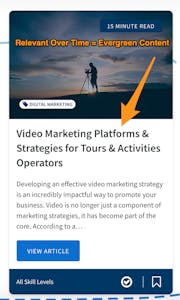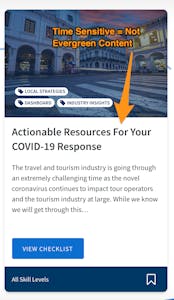- 10 minute read
- SEO
Why E-A-T Is Important for SEO (Expertise, Authority, Trust)
Beginner,
Intermediate
Join hundreds of other operators and REGISTER NOW for Spark 2024 New Orleans October 13-15th!

Like the plants that remain green and hold their leaves throughout the year, evergreen content stands the test of time, remaining popular and relevant long after it was written. It holds the interest of its target audience, remains factually accurate, and its format meets the standards for audience engagement. Since evergreen content is so well-optimized for search engines, it continues to rank for keywords related to your niche while generating plenty of organic traffic to your website or blog.
More often than not, the evergreen content you write for your website will live on your blog, but it can also be used to optimize sections of your website like an About page or other informational pages. Blogging is one of the most effective ways to drive traffic to your site, establish yourself as an industry expert, and develop a community of readers and potential customers. If you’re new to blogging, be sure to take a look at our intro to blogging video and helpful do’s and don’ts to keep in mind.
This guide will cover examples of evergreen vs. non-evergreen content, why crafting evergreen content for your blog is so important, and how to brainstorm topics and update existing content to continue reaping the benefits.
 Evergreen content revolves around topics that will always be relevant to your readers — such as a guide to things to do in your area — regardless of the season or any other current events. Example topics include how to dress for a hiking tour, the best questions to ask your tour guide, or the best ways to tie a sailor’s knot, to name a few (we provide more sample blog posts at the end of this guide!). These topics never go out of date and likely won’t need to be updated often.
Evergreen content revolves around topics that will always be relevant to your readers — such as a guide to things to do in your area — regardless of the season or any other current events. Example topics include how to dress for a hiking tour, the best questions to ask your tour guide, or the best ways to tie a sailor’s knot, to name a few (we provide more sample blog posts at the end of this guide!). These topics never go out of date and likely won’t need to be updated often.
On the other hand, content that would not be considered evergreen includes press releases, new trends in your industry, event promotion, new statistics, and content of a similar nature. Let’s say your business just hired a new tour guide and you want to introduce him on your blog as the newest recruit. While this is definitely worth featuring (and shows off the personality of your business), it’s not an evergreen topic, since he won’t be the new guy forever. This news is timely now, but it may become dated in a short time.
 When it comes to your content strategy, having a mix of both evergreen and non-evergreen posts is beneficial for your site since there are circumstances where each type of content will best serve your goal. If everything you write for your blog is evergreen, your business could come across as unapproachable, so it’s important to inject your personality into your online presence through more timely (non-evergreen) posts.
When it comes to your content strategy, having a mix of both evergreen and non-evergreen posts is beneficial for your site since there are circumstances where each type of content will best serve your goal. If everything you write for your blog is evergreen, your business could come across as unapproachable, so it’s important to inject your personality into your online presence through more timely (non-evergreen) posts.
Despite the fact that non-evergreen content loses relevancy over time, it is critical to incorporate it into your content strategy to show that you are in tune with industry trends, responsive to local and world events, and engaged with your community. On the other hand, evergreen content will continue to bring your website traffic and rank well in search engines, making it crucial to your content strategy.
 Pro tip: Some content creators follow the 80% rule for balancing timely and evergreen content. By this standard, 80% of your blog content should be evergreen, while the other 20% digs deeper into the evolving facets of your business and any timely happenings.
Pro tip: Some content creators follow the 80% rule for balancing timely and evergreen content. By this standard, 80% of your blog content should be evergreen, while the other 20% digs deeper into the evolving facets of your business and any timely happenings.
Much of the content on your website will be timely, as tour offerings change, new promotions come into play, and seasonal updates are posted. For the purposes of increasing organic traffic and reaching a wider audience with your evergreen content strategy, it’s best to focus on your blog.
 Benefits of Evergreen Content
Benefits of Evergreen ContentEvergreen content and SEO go hand in hand. Unlike non-evergreen blog posts that may see a spike in traffic directly after being published, followed by a plateau (or even a decrease), traffic to evergreen posts grows and continues to increase over time. In fact, 75% of Hubspot’s blog views are for “old” posts, and 90% of their leads come from these posts.
The key is using high-volume keywords to inform your topics and checking for a positive trend over time — meaning the topic shouldn’t be seasonal or on a decline. Take a look at how to perform keyword research in this guide.
Another SEO benefit is the possibility of attracting links. If you write in-depth and informative content, other websites are likely to link to it as a resource, driving more traffic to your site. Read more about creating a link building strategy here.
SEOs and website owners have recently begun to understand the importance of E-A-T (Expertise, Authoritativeness, and Trust) and how Google uses these guidelines to determine the quality of a page. When you publish useful information about your industry, you establish yourself as an expert in your field, building authority and trust among readers.
When it comes to blogging, you can boost your E-A-T by doing things such as creating author bios and including them in each blog post. This allows you to demonstrate the expertise of the writer and their knowledge of the industry and lends more credibility to the information you have provided. Use the bio to provide background about the author to show why your readers should trust them. Include information such as years of experience in the field, relevant education, and any awards or accolades they have received.
One of the best reasons to write evergreen blog posts is to attract and educate a wide audience, as opposed to only focusing on potential customers who are in the process of looking for tours and activities to book. Content that addresses frequently asked questions about your industry not only provides readers with valuable information but also introduces them to your business, potentially turning them into customers down the road.
 Evergreen Content Best Practices
Evergreen Content Best Practices Evergreen Content Ideas for Tour & Activity Operators
Evergreen Content Ideas for Tour & Activity OperatorsDon’t forget to revisit your posts! Evergreen content shouldn’t require too much upkeep, but it’s a good idea to check in periodically and see where you can improve the content, especially if it’s received a lot of interaction from your audience. For example, if people are commenting on a certain section or asking a question that the content doesn’t answer, consider updating to improve the quality of the post and keep it up to date.
One of the best ways to see how your content is performing is to conduct a content audit. Continue driving traffic to your blog by reminding your social media followers about some of your best evergreen posts (especially when you make changes to them).
For more tips on blogging, check out our content marketing guides.